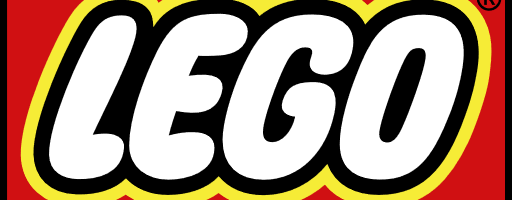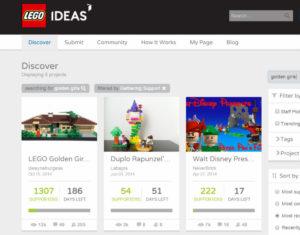Lego Ideas: Leveraging crowds to design your product for you

LEGO IDEAS
One company that is leveraging crowd sourcing to design creative new products while simultaneously building a community based platform is LEGO through its LEGO ideas website. Users are given freedom to design their own lego products from scratch using free software provided by Lego and then vote on the ideas that they like best. Lego takes the most popular designs and actually finalizes, manufactures, and sells them as LEGO branded products. It is a great way for the company to get innovative new ideas for products for a very low cost, while simultaneously engaging customers with the brand through an online community. [1]
How it works
The platform consists of several elements: user submissions, user discovery, community and blogging. Users can design their own project using the platform’s “project page” that enables users to build extremely detailed custom Lego projects through a software program that enables LEGO to seamlessly convert the final design into a product that can be manufactured. Next, users submit the finalized designs for all of the community to see. Using the “discover” section (see below for screen shot), users can then browse all submitted projects using various filters (such as recent or most supported) and “support” projects that they like and would like to see turned into a purchasable set. Additionally, they can leave comments and suggestions to discuss different elements of the design. In addition to these features, there is also a community page where users can browse profiles of other users, sorted by “clutch power” which is a resource that members get for participating in activities throughout the site. Finally, a blog section exists for selected users to share more about themselves and why they have such a passion for design work as well as how they thought of their ideas.  Screen shot of “discover” page
Screen shot of “discover” page
All designs that gain 10,000 votes of support in a 6 month period are deemed “eligible for review” where Lego decides whether or not it will actually manufacture and sell the designs. Primary reasons that designs are rejected by the company after proving high levels of support are IP infringement, inappropriate content for younger users (such as guns, sex references, or alcohol), and design characteristics that would make the project unprofitable (such as too many unique pieces).
Incentivizing participation
The primary motivation for a user to develop a design on the platform is that they get the chance to design a LEGO set that they would love to actually own and have a real chance that LEGO will produce it. As a kid I would have absolutely loved something like this as I dreamed up ideas for sets that did not exist, and this platform would have given me some hope that one day my ideas could become reality. However, the other two primary tools of motivation for users to design ideas is money and community recognition. First off, any user who develops an idea that makes it all the way through and is selected to be developed into an actual LEGO set is given a free copy of the produced set and a 1% royalty on all sales associated with it (which could potentially be a decent amount of money).[1]
Value Creation and capture
This crowdsourcing platform is rather genius in that it creates value in several different ways, while allowing the company to capture nearly all of it (at least the financial value). For starters, the obvious value created is the actual designs that are crowdsourced: Lego gets thousands of free design submissions without having to actually produce any of them unless their specific design criteria are met. The designs that ARE selected have all received 10,000 votes of support by the community, which indicates that demand for these sets will be relatively high once they enter into production. Additionally, because Lego has created an active community around the platform, users become more engaged with the Lego brand and are probably more likely to buy Lego products (particularly the designs that are crowd sourced) as a result. [2]
Users receive a 1% royalty which is not particularly high given that they did what is perhaps the hardest part of the process for Lego (creative idea generation and demand testing), but also receive a high amount of value associated with being recognized within the community through status points on their profiles and high rankings on the “most supported” projects. These things are valuable to the users but cost Lego very little money to do. [3]
Challenges
Selecting appropriate design criteria while still giving freedom of creativity to users: Lego puts relatively strict design criteria that can cause them to reject producing user generated concepts that generate 10,000 votes of support. These criteria disallow certain themes, IP infringement violations, and help weed out unprofitable overly complex designs. However, in 2015 these criteria were set a little too strict, and in one phase none of the projects that reached 10,000 support votes met the criteria. This is potentially a large problem as it destroys a lot of user’s motivation to participate and submit additional designs if none are being produced. [4]
Managing inappropriate posts and offensive concepts: Because users are given a high degree of flexibility with their designs (they can literally come up with anything built out of Legos), they can potentially post content that is offensive to other users. In order to manage the community, Lego added a “flag as offensive” button to all posts that users can submit – which allows them to monitor and remove offensive posts without having to pay an employee to constantly scan posted content.
Growth potential
Over 20 crowdsourced concepts have been produced by Lego since the launch of the platform and activity on the platform is still quite high (there are currently several projects nearing 10,000 votes and multiple with hundreds of comments). While I don’t see this as a channel that will actually displace Lego’s traditional design processes, it will surely serve as a useful complement to it going forward, while also building a community around the brand that will make all of its customers more loyal.
SOURCES
[1] https://ideas.lego.com/
[2] http://blogs.wsj.com/digits/2015/02/25/legos-plan-to-find-the-next-big-hit-crowdsource-it/
[3] https://www.crowdsource.com/blog/2015/04/crowdsourcing-win-lego-taps-into-the-crowd-to-drive-product-innovation/
[4] http://www.brothers-brick.com/2015/10/30/lego-ideas-fails-all-15-projects-in-first-round-of-reviews-for-2015-news/



Hey Scott. Great post! One thing that I find very interesting about this is that besides getting designs for free, Lego is also getting an idea about the customer demand based on who in the community voted on the designs. For e.g. if a particular Star Wars themed Lego set was mostly voted upon by males between 20-30 years then this information will shape Lego’s marketing and sales strategy for this themed Lego set, thereby, leading to reduced marketing and distribution expenses. Similarly if a particular theme was very popular in France but nowhere else then Lego could just stock the product in France and not invest in inventory around the world.
Hi Scott, nice article. Interesting how Lego is using digital tools to crowdsource idea generation. A couple of questions / thoughts
1. Do users with more clutch power get a preference in enabling their ideas to be more discoverable or getting some other kind of preferential treatment?
2. I presume that most of the members of the digital community would be adults. Does Lego somehow try to get the voice of children (who are the primary LEGO users) on the designs submitted?
Hi Scott- Great post! To Bipul’s point, the value of the data on customer interest / demand that Lego receives from these contests is huge. Are you able to provide any examples of how Lego has used this data to support a shift in strategy? I’m sure the data is used, but it would be interesting to know one or two concrete examples, if any come top-of-mind.
Second, what’s important to the success of contest-based crowdsourcing tactics is that there are clear incentives, yes, but also that users feel the selection process is transparent and fair. Many companies launch contests and are unclear about what they’re looking for in a winning entry, but not Lego. It’s actually quite impressive how Lego specifies what it’s looking for in submissions along with mentioning how important each variable is. I think this says a lot about how intentional Lego is with each contest-entry. The company knows the information that it wants to get from customers for each contest, which I think speaks volumes to the company’s management. Would be interested to know from someone who has worked at Lego whether the company is as mission driven as it seems.
Lastly, these contests are a great way for Lego to crowdsource its marketing efforts! One of the contests I looked at wanted people to submit creations “using stop-motion animation”. What a fun way to ask people to do part of your commercials. I wonder if the company has calculated the cost-savings this type of crowdsourcing generates for its marketing department.
Scott,
Thank you for the post and for the in-class presentation. It seems like this is a very beneficial and effective way to leverage crowds to increase customer loyalty and gain solid new ideas. My thought while hearing your presentation concerns the marketing of this contest. I have a few nephews and I bet they would love to participate in this contest (they’re big lego fans), but they’re not aware of it. Maybe this would become more popular and appeal to more lego consumers if they marketed it in stores or on lego boxes? Or, if marketing is not the issue, then maybe increase the value sharing with consumers beyond the 1% mark would bring more people in…college tuition, semester abroad, or the financing of some other programs geared toward the younger population come to mind.